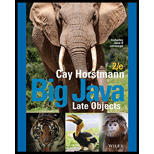
Big Java Late Objects
2nd Edition
ISBN: 9781119330455
Author: Horstmann
Publisher: WILEY
expand_more
expand_more
format_list_bulleted
Question
Chapter 23, Problem 6PE
Program Plan Intro
Program plan:
ReportPrintDB.java
- Import required packages.
- Create a class named “ReportPrintDB”.
- Create function “main()”.
- Check whether the length of command line argument is zero or not using “if” condition.
- If the condition is true, then print the message that there is no command line argument.
- End the program.
- Make a call to the “init” function of “BasicDataSource” class to initialize the connection.
- Use “try” block to create “Connection” and “Statement” objects.
- Create a ResultSet object named “customerResult” and then select the data from “Customer” table.
- close
- Using “While” loop, position the cursor using the “customerResult.next()” method and extract the data from each column of the current row of the ResultSet object.
- Create a “Prepared Statement” object and select the data from “Invoice” tables where “Customer_Number” is equal to “?”.
- Using “setInt()” function set Dynamic customer number during runtime.
- Print the retrieved “customerNumber” and “customerName”.
- Use “try” block and create the ResultSet object.
-
- Using “While” loop, position the cursor using the “invoiceResult.next()” method and extract the data from each column of the current row of the ResultSet object.
- Create a “Prepared Statement” object and select the data from “Product” and “Lineitem” tables where “LineItem.Invoice_Number” is equal to “?” and “Product.Product_Code” is equal to “LineItem.Product_Code”.
- Using “setString()” function set Dynamic invoice number during runtime.
- Execute the prepared statement and store the result into the “ResultSet” object named “totalResult”.
- Using “ totalresult.next()” moves the cursor forward one row from its current position and retrieve the values by column number.
- At last print and display the report of all customer payment details.
- Close the “invoiceresult” object.
- Using “While” loop, position the cursor using the “invoiceResult.next()” method and extract the data from each column of the current row of the ResultSet object.
- Using “While” loop, position the cursor using the “customerResult.next()” method and extract the data from each column of the current row of the ResultSet object.
- Close the “customerResult” object.
- Close the “conn” object
- Check whether the length of command line argument is zero or not using “if” condition.
- Create function “main()”.
BasicDataSource.java:
- Import required packages.
- Create a class named “BasicDataSource”.
- Create a function named “init()”.
- Create objects for “Properties” and “FileInputStream”.
- Load the file.
- Assign values for “driver”, “url”, “username”, and “password”.
- Check whether the “username” and “password” are “null” or not.
- Load the driver by checking whether the “driver” is not “null”.
- Create a function named “getConnection()”.
- Make a call to the “getConnection()” function of “DriverManager” class by passing the arguments “url”, “username”, and “password” to establish the connection and return to the called function.
- Create a function named “init()”.
Expert Solution & Answer
Want to see the full answer?
Check out a sample textbook solution
Chapter 23 Solutions
Big Java Late Objects
Ch. 23.1 - Prob. 1SCCh. 23.1 - Prob. 2SCCh. 23.2 - Prob. 3SCCh. 23.2 - Prob. 4SCCh. 23.3 - Prob. 5SCCh. 23.3 - Prob. 6SCCh. 23.4 - Prob. 7SCCh. 23.4 - Prob. 8SCCh. 23.5 - Prob. 9SCCh. 23.5 - Prob. 10SC
Ch. 23.5 - Prob. 11SCCh. 23.5 - Prob. 12SCCh. 23 - Prob. 1RECh. 23 - Prob. 2RECh. 23 - Prob. 3RECh. 23 - Prob. 4RECh. 23 - Prob. 5RECh. 23 - Prob. 6RECh. 23 - Prob. 7RECh. 23 - Prob. 8RECh. 23 - Prob. 9RECh. 23 - Prob. 10RECh. 23 - Prob. 11RECh. 23 - Prob. 12RECh. 23 - Prob. 13RECh. 23 - Prob. 14RECh. 23 - Prob. 15RECh. 23 - Prob. 16RECh. 23 - Prob. 17RECh. 23 - Prob. 18RECh. 23 - Prob. 19RECh. 23 - Prob. 20RECh. 23 - Prob. 21RECh. 23 - Prob. 22RECh. 23 - Prob. 23RECh. 23 - Prob. 1PECh. 23 - Prob. 2PECh. 23 - Prob. 5PECh. 23 - Prob. 6PE
Knowledge Booster
Recommended textbooks for you
 Database System ConceptsComputer ScienceISBN:9780078022159Author:Abraham Silberschatz Professor, Henry F. Korth, S. SudarshanPublisher:McGraw-Hill Education
Database System ConceptsComputer ScienceISBN:9780078022159Author:Abraham Silberschatz Professor, Henry F. Korth, S. SudarshanPublisher:McGraw-Hill Education Starting Out with Python (4th Edition)Computer ScienceISBN:9780134444321Author:Tony GaddisPublisher:PEARSON
Starting Out with Python (4th Edition)Computer ScienceISBN:9780134444321Author:Tony GaddisPublisher:PEARSON Digital Fundamentals (11th Edition)Computer ScienceISBN:9780132737968Author:Thomas L. FloydPublisher:PEARSON
Digital Fundamentals (11th Edition)Computer ScienceISBN:9780132737968Author:Thomas L. FloydPublisher:PEARSON C How to Program (8th Edition)Computer ScienceISBN:9780133976892Author:Paul J. Deitel, Harvey DeitelPublisher:PEARSON
C How to Program (8th Edition)Computer ScienceISBN:9780133976892Author:Paul J. Deitel, Harvey DeitelPublisher:PEARSON Database Systems: Design, Implementation, & Manag...Computer ScienceISBN:9781337627900Author:Carlos Coronel, Steven MorrisPublisher:Cengage Learning
Database Systems: Design, Implementation, & Manag...Computer ScienceISBN:9781337627900Author:Carlos Coronel, Steven MorrisPublisher:Cengage Learning Programmable Logic ControllersComputer ScienceISBN:9780073373843Author:Frank D. PetruzellaPublisher:McGraw-Hill Education
Programmable Logic ControllersComputer ScienceISBN:9780073373843Author:Frank D. PetruzellaPublisher:McGraw-Hill Education

Database System Concepts
Computer Science
ISBN:9780078022159
Author:Abraham Silberschatz Professor, Henry F. Korth, S. Sudarshan
Publisher:McGraw-Hill Education

Starting Out with Python (4th Edition)
Computer Science
ISBN:9780134444321
Author:Tony Gaddis
Publisher:PEARSON

Digital Fundamentals (11th Edition)
Computer Science
ISBN:9780132737968
Author:Thomas L. Floyd
Publisher:PEARSON

C How to Program (8th Edition)
Computer Science
ISBN:9780133976892
Author:Paul J. Deitel, Harvey Deitel
Publisher:PEARSON

Database Systems: Design, Implementation, & Manag...
Computer Science
ISBN:9781337627900
Author:Carlos Coronel, Steven Morris
Publisher:Cengage Learning

Programmable Logic Controllers
Computer Science
ISBN:9780073373843
Author:Frank D. Petruzella
Publisher:McGraw-Hill Education